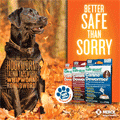Retriever Training |
|
||||||

Featured Articles
Getting Your Puppy to Come Back
Last issue we discussed building retrieving desire, the single most important objective of puppy work. In this column we give another important tip on maximizing a pup’s focus and motivation, and discuss an issue which comes up with almost all good puppies: how to get the pup to come back to you. (Continue)
Favourite Set-ups: Picture Perfect Multiple Blinds (with a teaching bonus) In this series of Favourite Set-Ups, I have been describing only marking set-ups. In this issue, I will discuss favourite set-ups for land blinds. Previously, I have described several concepts important to consider when designing blinds. One of the most important is the idea of 3-Peats. Three-peats are a set of three blinds which emphasize a similar concept. The repetition allows additional opportunities to practice and reinforce teaching a dog to deal with a factor. Examples are 3-peats with a crosswind, angling a road or ditch, a patch of cover or crossing a pot hole. The concept of factor repetition in a set of blinds will become part of our Favourite Blind Set-Up. (Continue) Proper Introduction to Birds and Gunfire - An Interview with David Lauber Last month we spent time talking with David Lauber, regarding the proper way to introduce dogs to birds. This month we will continue that discussion as he explains moving from yard work to fieldwork with birds and introducing gunfire to young dogs. (Continue) |
Take a Look Inside Our Online Store
More Featured Articles
Advanced Marking Drills
At some point, when your young dog is doing so well on his singles that you can’t wait to try something more advanced, you are ready for the introduction of doubles. We always start this as a "schooled double," that is, by employing a single, or a mark that the dog has already practiced, and then throw another dummy as a diversion. (Continue) Establishing an Effective Pattern in Hunting Dogs The two hunters were working their way through a CRP field, following a black Lab that was covering ground by running straight out and back again. Suddenly, a cackling rooster flushed to the side and behind them, setting its wings and sailing straight away into the wind. The pair spun around at the sound, but were so surprised that neither could get a shot off. Both knew the dog had a great nose; they'd seen him smoke birds from 20 yards on other hunts. But it wasn't until they'd stood for a minute with the breeze in their face that they realized their mistake: Improper patterning and ineffective use of the wind had been the culprits in this case. (Continue) Stand Alones This procedure means that the Amateur can never complain about not giving his dogs marks because he has no help. I, of course, realize that a dog must be exposed to multiple gunners (doubles, triples and quads) and there is little substitute for multiple gunners or multiple remote-control bird throwers. The experience of watching multiple throws, remembering their marks and dealing with their interaction is best addressed with the real thing. However, as I have often hinted in ONLINE, stand alones can be used to advance many marking skills. This article will describe the 2 major types of stand alones (roving stand alones and one-place stand alones or send backs) and how to do them.(Continue) |
Request a FREE Catalog Preparing a Retriever for Duck Hunting It’s never good when someone takes a young retriever duck hunting for the first time and then doesn’t understand why their pride and joy is picking up sticks in the water and grabbing the decoys and bringing them back instead of retrieving ducks. If that dog has never been in a duck blind before, it’s understandable to me, but hunters are always asking themselves, "Why isn’t my brand new well-bred, super expensive retriever sitting there like he’s supposed to, and retrieving like he’s supposed to; heck, he does it perfectly in the backyard."(Continue) Force Fetch Force Fetching Retrievers is difficult, especially when you lack experience. When a dog does not respond, do you need to apply more pressure, less pressure, ease up on requirements, shorten the session, or perhaps bear down and keep trying until he gets it? Even experienced trainers can find it hard to read a dog that is doing nothing. (Continue) |
|||||
|
|
|||||||
Copyright ©2026 Geoffrey English - All Rights Reserved

 Manufacturers, Guides / Outfitters
Manufacturers, Guides / Outfitters
 Kennels and Trainers
Kennels and Trainers
 When you advertise with us you know you are reaching a targeted audience with a desire to learn more about training / caring for hunting dogs and who have a proven track record of purchasing hunting dog related supplies.
When you advertise with us you know you are reaching a targeted audience with a desire to learn more about training / caring for hunting dogs and who have a proven track record of purchasing hunting dog related supplies. 

















